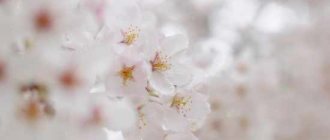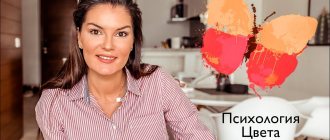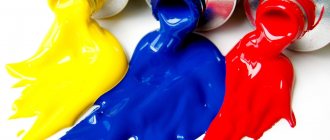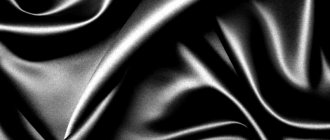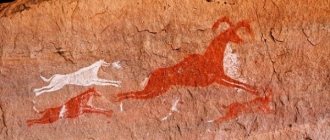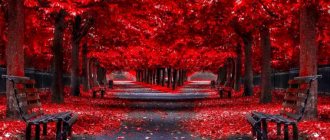The influence of colors on the mental state of people has been studied since ancient times. Each of them means something. When looking at a certain color shade, a person experiences certain feelings that affect the rise or fall of mood. Often people are inclined to choose a certain option without even thinking about the fact that this decision was influenced by color.
Why certain colors are used in different fields of activity, and how to apply color characteristics for your own purposes is described below. We're talking about the color brown.
Positive meaning of brown in various cultures
For the ancient Greeks, brown color was closely associated with the image of the goddess of the life cycle and fertility Hera and was considered one of the most honorable and used in everyday life. Rich chocolate shades of the brown spectrum were revered by both the ancient Egyptians and the aborigines of the African continent, and in each case the color of the earth was considered a symbol of home, stability and strong family relationships.
In Slavic life, brown color was rarely found, and then mainly in the form of the natural color of various labor materials, which corresponded to its symbolic meaning - mother earth. The Russian ancestors of the simple class avoided wearing clothes of dark, brown shades - it was believed that only the animal that was the totem of the Slavs - the bear - was allowed to have this color, as well as the powerful of this world - princes and eminent citizens. Everything that was compared with the cult image of the forest owner: strength, perseverance, indestructible ferocity - was automatically associated by our ancestors with the color brown.
Violet
The color of human spiritual strength. Helps you focus on the main thing and inspires inspiration. He is loved by creative people, people with unconventional thinking, he is able to balance the spiritual and material. Associated with something exclusive and creative. The color violet stimulates brain function well; it is often used on packages of chocolate, raisins, and nuts. Recently, purple has often been used in the design of modern interiors; previously it was considered a majestic color, which was always present in the clothes of kings.
Possible negative associations: Lightning is often depicted in shades of purple, which evokes thoughts of the supernatural and mystical. This color can be perceived in completely different ways; for some it is the color of power, spirituality and wisdom, and for others it is fanaticism, alienation and even death.
Negative meanings of brown
Most modern people have a cool attitude towards the color brown, and there are many reasons for this, given the influence on the minds of various religious and historical facts associated with coffee and chocolate shades. Thus, since ancient times, Islamists have been of the opinion that dark, earthy tones are symbols of social and moral decay, devastation, and ignorance. Representatives of the Catholic Church of the Middle Ages believed approximately the same thing - this color, in their presentation, personified the poverty of life and spirit, moral decline, incest and lust.
Christianity interpreted wearing dark brown clothes as a sign of worshiping the devil and serving dark forces, but the peak of negative attitudes towards this color occurred in the 20s of the last century. This period was marked by the popularization of the fascist movement in Germany, which, thanks to the brown form of aggressive youth, remained in history under the name “brown plague.”
Black
Black always hides everything it carries, being the most “mysterious” color. Balances white color (without darkness there is no light, yin and yang). Correlates with infinity, helps to concentrate and isolate oneself from all extraneous colors. In its pure form, it is used quite rarely, because... causes negative emotions. It is usually paired with warmer, brighter colors to create more contrast. Black color is classic; black suits for men are an integral part of business style. Indispensable for creating clear shapes and lines.
Possible negative associations: Causes a feeling of bitterness, heaviness, despondency. Often associated with mourning. In this case, combining it with red can help; it will add dynamics and aspiration to black.
Brown color in psychology
Despite its conservative and respectable appearance, brown is rarely on anyone's list of preferences for long enough. Even more rarely, it accompanies a person throughout his life. What does brown mean in psychology? Experts note that the desire to surround oneself with brown and coffee shades is observed in a person with the following changes in mental state:
- with depressive disorder and loss of self-confidence;
- if necessary, get rid of difficult thoughts or get out of a protracted conflict situation;
- for chronic fatigue, mental “burnout”.
Teenagers often choose this color, trying to get away from the sensuality awakening in them and to drown out their protest against their usual way of life. An even, natural color gives a feeling of stability and serves as a guarantee that everything will work out well and as it should.
People who do not get enough sleep, are exhausted from work or are often exposed to stress, instinctively strive to bring a lot of brown details in soft tones into their wardrobe or home interior. The abundance of such elements gives a feeling of physical liberation, peace, and harmony.
Rejection, a categorical dislike for the color brown, is characterized in psychology as a desire to rise above the primitive needs of the body. Bright individualists, spiritual personalities, and creative people do not accept dark shades - from coffee to clay.
What does brown aversion mean?
Brown, like black, leads in negative attitudes towards them.
For some, it does not evoke the best associations, while others simply do not like it because they consider it boring and banal.
Most often people who are too impulsive , those who live “one day at a time” and those who do not think for a long time when making any decision do not like him. For them it is boring, it lacks colors and brightness.
He is also not liked by those who constantly want to stand out from the gray crowd, who do not like routine and sameness. Often these are creative people who find it difficult to sit in one place.
Brown is also viewed negatively by those who are trying to establish themselves in life, to show that they are individual and different in some way from others.
Zodiac preferences
Since in psychology the value of brown color is emphasized as a factor of “grounding”, a return to nature and natural simplicity, this color is ideal for two zodiac signs - Virgo and Capricorn.
The practical Capricorn always strives to remain unconvinced, but he hates to complicate everything and, in search of the truth, inevitably returns to the basics. Capricorn has a vital need to periodically turn to the experience of his ancestors, and the brown color helps him not to lose this connection and remain something of a keeper of family traditions and ancestral memory.
Thoughtful and pedantic, Virgo never has her head in the clouds, and in all matters prefers to use the shortest path to solving a problem. Dark shades such as “brown”, “mahogany”, “chocolate” help Virgo to concentrate and not be distracted by unimportant details.
Blue
Blue is a concentric color, it dedicates everything only to itself. This color has “no bottom”; it never ends, pulling you into itself. Blue color is constancy, perseverance, perseverance, devotion, dedication, seriousness, rigor. It has a very strong psychological value, being the color of persuasion, but not as emotionally oppressive as red. Symbolizes eternal values, height and depth, wisdom and rigor. Dark blue color is considered businesslike, professional and authoritative - it’s not for nothing that businessmen love it so much. Helps you concentrate on what is essential. A blue detail in a catalog or advertising brochure will immediately attract attention, but unlike red, it will almost never cause negative emotions.
Possible negative associations: Blue is not only the color of the sky, but also the color of the night; it can be associated with magic, strange things, witchcraft, oppression, fanaticism.
Brown color in the Luscher table
The Luscher color test defines brown as a deep yellow-red, looking passive enough not to appear impulsive. As a rule, the test taker places a card of this color outside the periphery of the key zone, which is the absolute norm. This means that a person evaluates his physical condition as satisfactory and does not consider it necessary to concentrate on health issues.
A brown card that takes its place among the first in the row is considered an alarming sign, indicating the patient’s subconscious fear for his life, freedom and safety. People who do not have their own home, are chronically ill, or are deprived of family ties, thus declare their priority desire to get rid of the problem, and not to acquire something new. Perhaps behind the desire to isolate yourself is a heavy dependence on finances, a failed personal life, or accumulated fatigue.
Bordeaux
Burgundy color is an indicator of solidity, confidence, and conservatism. It is moderate and is associated with stability and resilience. People who prefer this color are self-confident, without unnecessary emotions, assertive but enterprising, with good organizational skills. Burgundy is considered an exquisite color, so it is often used in the design of restaurants and furniture showrooms.
Possible negative associations: Heavy, depressing. The use of this color should be moderate, because... in large quantities it can put pressure on the psyche and create depression. It can be associated with the color of antiquity, but in combination with gray it becomes an indicator of prosperity and solidity.
Clothes in brown tones
Psychologists call the brown color in clothing both the choice of the powerful and the preference of the vulnerable. The first category of people belongs to the true connoisseurs of a practical life position - it is important for them that their clothes are always impeccable, do not get dirty, and do not serve as the subject of undue attention. This color is chosen by hidden manipulators, as well as very thrifty people who live with a constant eye on their peace of mind and sense of inner comfort.
The second category reveals emotionally depressed people who are looking for support on a physical level - financial stability, material wealth, family status. In such clothes, especially if they include 2-3 shades of brown in muted tones, it is easy to hide in the crowd after waiting out some difficult period in life.
Now a few words about the psychology of women. The color brown in a lady's wardrobe is closely associated with the bleak, baggy clothes of Soviet times, when bright fabrics were difficult to obtain and the fair sex was forced to dress almost alike. For this reason, modern women very rarely buy toiletries in chocolate and coffee shades, although dark colors can favorably emphasize the advantages of a figure and hide flaws.
Young people should not get carried away with painting their lives in chocolate tones, as such a choice can visually age a person and give the image a touch of fading. It is better to focus on beige shades, complementing the suit with bright, contrasting accessories.
Application in advertising
Brown psychology is also used by advertisers. Along with green, brown is used in advertising to emphasize the naturalness of the product being offered. For example, manufacturers package organic cosmetics in beige or brown paper. The same applies to food.
The stability of brown in advertising for banks and other financial institutions attracts new customers.
Catering establishments choose this color to develop their logo. Thus, their coziness and the quality of the cuisine are emphasized.
Companies with a long history use color to create the status of a reliable, stable and proven organization.
Interior solutions
Color psychology considers the presence of brown in the interior as a desire to enhance the energy of stability and peace in the house, to give the home a solid and at the same time discreet appearance. Floor coverings and furniture are usually made in brown, chocolate and coffee shades.
Even if a person does not welcome the dark brown color, both psychologists and bioenergeticists strongly recommend including it in the interior of the home. It is not necessary to fill the rooms with furniture arrays of an irritating shade - it is enough to use it in the decoration elements of the surrounding environment.
Feng Shui adherents assign a special position to the color brown in the house and actively use it in the eastern part of the home, which is responsible for health and family well-being. In this zone it is good to relax after a working day and gain strength before any decisive event.
Color associations and character
For each color, we have negative and positive associations, which is associated not only with physiological reactions to it, but also with cultural upbringing.
Red color
If a person is placed in a room with an abundance of red color, then his blood pressure may even briefly increase, his pulse will increase, and his breathing will speed up. In addition, the color red makes us think that time is passing faster than it actually is.
Associations with red color of saturated tones: energetic, sexy, cheerful, ardent, active, aggressive, hot, excited, warm, holy, patriotic, dry, militant, restless, tense, sinful, hatred, anger, decreased profits, something that knocks down confusion, fear, rebellion.
German scientists have determined that the red color of a football team's uniform increases the chances of winning when playing on their own field.
The presence of red in the image increases the attractiveness of both men and women. Women who wear red seem more interesting and beautiful to men.
It is believed that people who prefer the color red
— passionate, with pronounced leadership qualities, emotional, purposeful, prone to extreme sports.
Pink color
Associations with the color pink of rich tones: exciting, happy, exciting, the color of love, young, cheerful, sensual, girlish, infantile, immature.
Pastel pink evokes other associations: soft, sweet, gentle, childish, cozy, subtle, romantic, feminine, affectionate, intimate, weak, fragile, sentimental.
People who prefer pink
, often soft, gentle, weak-willed and dreamy natures, love comfort, are infantile.
Orange color
Associations with the color orange of rich tones: productive, tasty, warm, cheerful, courageous, fearless, curious, childish, happy, energetic, hot, juicy, sociable, friendly, loud, radiant, responsive, comedic, proud, ambitious, cheerful, joyful , lively, impetuous, young, dangerous.
Orange
- the color of cheerful and active people, dreamers with developed intuition.
Yellow
Yellow is a tonic and invigorating color.
Associations with yellow color of rich tones: joyful, hospitable, decisive, noble, young, speed, movement, Sun, friendliness, energy, intuition, intelligence, favorable, safe, highly spiritual, healthy, cheerful, loud, meanness, cowardice, stupidity, deception , betrayal, jealousy, envy.
Associations with yellow-orange color of rich tones: enterprise, determination, wealth, cheerfulness, fun, aggression, strength, energy, warmth, pleasure, health, pride, importunity.
Yellow
- the color of sociable, brave and intelligent people who know how to adapt. Usually this color is not liked by pessimists and introverted individuals.
Green
Green and blue tones, unlike red, can reduce blood pressure and muscle tension, calm the nerves, and relax.
Associations with the color green of rich tones: life, benefit, movement, infancy, nature, hope, peace, abundance, adaptability, silence, undemanding, peaceful, soft, not nervous, serene, thoughtful, concentration, meditation, coolness, abundance, health, sympathy, weak, inexperience.
The green color of the text can evoke agreement with the statement.
Green
- the color of sincere and honest people
Violet
Associations with purple-violet rich tones: nostalgia, memories, strength, spirituality, infinity, dignity, contemplative, mystical, night, conservative, thought, royalty, nobility, melancholic, mourning, pomp, loneliness, despair, sadness.
Associations with red-violet rich tones: sweet taste, sophisticated, thirst for tenderness, romanticism, excitement, passion, creativity, unique, cunning.
Violet
- the color of creative and emotional people.
Blue and cyan
Associations with blue saturated tones: dignity, moderation, calm, rich, pleasant, strength, robot, relaxation, maturity, quiet, cold, reliable, composure, melancholy, emptiness, sadness.
Shades of blue serve to relax, relieve tension and anxiety.
Blue
- the color of spiritually developed people, sublime, often melancholic and modest.
Brown
Associations with earth tones: simple, rich, warm, friendly, life, courageous, durable, safe, familiar, dirt.
Brown
- the color of self-confident and conservative people.
White
Associations with the color white: light, coolness, snow, purity, clarity, reliability, innocence, silence, normality, harmony, knowledge, spirituality, youth, emptiness, fear, sadness, work.
White color
Almost everyone likes it, so its interpretation is ambiguous - it can mean cold, spirituality, harmony.
Grey
Associations with neutral gray tones: quality, calm, inertia, practical, old, cold, smart, sensible, silent, selfishness, depression, indifference, independence, indecisive, deception, lack of strength.
Grey
- the color of sensible and cautious people.
Black
Associations with the color black: clash, strong, elegant, mysterious, heavy, prestigious, cold-blooded, unemotional, noble, despair, silence, reserved, negative, despondency, hatred, malice, anger.
In Western culture the color black
is the color of mourning, while in the East it is a symbol of goodness, nobility and experience.
The effect of brown color on physical condition
If a person periodically likes the color brown, psychologists advise him to pay attention to his health, since such unexpected sympathy may indicate an unconscious desire to get rid of the problem on the physical level.
Because all brown shades contain warm, stimulating notes of orange and red, this color will be useful for:
- circulatory disorders;
- weak immunity;
- chronic fatigue;
- interruptions in heart rhythm.
At the same time, color therapy with the inclusion of coffee and chocolate notes of the brown spectrum helps reduce the activity of brain processes, regulates blood pressure, and normalizes sleep.
Physiological effects
Brown color has a complex structure, therefore it combines both positive and negative properties. Cold and warm energy manifests itself depending on the purity and saturation of the shade. Brown-red and orange shades have a warming effect. It stimulates blood circulation and improves immunity. Psychologists and physiologists recommend wearing items or clothing of these shades to increase strength and replenish energy.
Light brown improves memory and helps concentrate. It is recommended for use by people associated with mental activity. It is believed that a brown stone or candle will help you pass an exam or test.
Rich and deep shades of brown have a calming effect. These colors help extinguish strong emotions, relieve stress and anxiety. At the physiological level, dark brown helps slow down metabolism and stimulate the nervous system. Any item of this color can slightly lower blood pressure and soften anger.
Impact on the psyche
Psychologists call the color brown “prepossessing” and “inspiring trust.” When going through difficult life stages, people tend to return to their origins, to be closer to nature - that is, to turn to what accompanied humanity throughout the entire path of its formation. By calling on the color of the earth or tree bark for help, a person begins to see the situation from the perspective of the shortest path to realizing his goal.
Sometimes, in order to solve an important problem, you need to temporarily abstract yourself from society, concentrate on your feelings and identify goals. In this case, the person will unconsciously strive to become invisible, to close himself with a shell that no one will have the desire to look under. The ideal choice for blending in with the crowd would be neutral shades of brown - taupe, clay, olive.
Origins
The name of the shade comes from the word “cinnamon,” which in turn is a diminutive of “bark.” This etymology reveals the essence of brown - it resembles the color of tree bark, as well as spices.
This is one of the most common shades in nature. In addition to the bark, many types of soil, the eyes and hair of people, and the skin of many ethnic groups have this color. It is colored with various spices and spices (cinnamon, vanilla and star anise), coffee beans, tea, precious stones and minerals (jasper, carnelian, citrine, agate and tiger's eye). It is often found in the colors of mammals, reptiles, insects and birds. This is usually due to the need for mimicry, that is, camouflage.
Brown lovers - who are they?
Psychologists divide those who love the color brown into two conditional categories: “those in need of protection” and “self-sufficient.” For the former, sympathy for the chocolate and coffee environment flares up suddenly or intensifies in waves, and then, with the loss of need, fades away. These people, as a rule, are defenseless in the face of difficult life circumstances and are in dire need of stability and constancy.
“Self-sufficient” include conservatives who consciously perceive life as endless resistance to opposing forces. The characteristics of people whose favorite color is brown are as follows in psychology:
- low creative quotient;
- high efficiency;
- pragmatism and prudence;
- lack of daydreaming and adventurism;
- consistency and logic.
Fans of dark coffee tones are not artistic or sociable, but they are wonderful friends and excellent leaders. The only clear fear of these people is the need for spontaneous actions, which they will try to avoid with all their might.
Silver
The color silver comes out of the gray, expresses the desire for freedom and an attempt to overcome all restrictions. Embodies nobility, safety, strength. Association words: lighting, reflection, penetration, impartiality, smoothness. Silver is a fairly cool color; it is used in small quantities on packaging; it is “more modest” than gold and, with its cold shine, adds a proud aristocracy to objects. Most often, this color is used by manufacturers of cars and equipment; thanks to its direct association with metal, silver seems stronger and more reliable.
Possible negative associations: Like grey, silver can be considered a color of indifference, and due to its metallic sheen it is colder and more unapproachable. Other associations: deceit, duplicity, illusoryness.
A little about the psychology of color combinations
Psychologists have found that the number of colors used directly affects the effectiveness of the advertising message. If the efficiency of perception of a black and white image is taken as 100%, then the efficiency of a two-color image increases by 20%, and a multicolor image by 40%. For advertising purposes, it is generally not customary to use more than two different colors, but they can be varied by using similar shades, as this creates a sense of color consistency and is not irritating to the eye.
When creating a new product, it is very important to consider that in the future it becomes more successful if the color scheme is used correctly, which over time becomes a corporate color scheme. You must also take into account the fact that colors tend to appear one within the other. This means that adjacent colors can enhance or cancel each other out. Thus, cigarettes in a brown and white pack, due to their white color, seem weaker than those in a brown one. When they are brown-blue or brown-gold, they acquire not only a strong, but also a somewhat aristocratic taste.
Sometimes several colors located nearby give a completely unexpected effect. For example, red represents energy, movement, danger, rage, and black – mystery, sadness, sadness, but the combination of red and black immediately transforms into something extravagant, piquant, alluring. But the combination of red with another, bright and emotionally rich color can look tasteless and irritate the eye. Therefore, all colors should be in harmony with each other, balance, but not suppress. The color that should carry the main psychological and emotional message should be the main and dominant one.
Color manipulation
If a person reading this article caught himself thinking that it’s time to put things in order in his life, then it’s better to start by adjusting the color scheme of the surrounding space and wardrobe. Surprisingly, even 1-2 accessories in clothing and a couple of additional details in the decoration of the room, made in a rich chocolate or pleasant cinnamon color, can bring harmony to the mind of the owner and make him more collected.
When applying for a job in an important government position or in an office where compliance with a dress code is required, psychologists recommend wearing a brown jacket or good dark shoes of a rich coffee color. This will serve as a signal to the employer that he is a responsible and balanced person. But for workers in the food industry or doctors, the color brown in everyday wear is contraindicated - it will cause unpleasant associations and can serve as a reason for dissatisfaction among others.
What kind of people choose this color?
Our favorite permanent color speaks about our temperament and character, and the one we choose at a particular moment or situation reflects our mood. What can brown tell you about the person who chooses it? Psychology claims that our attitude towards it reflects our attitude towards our body, towards sensations, towards natural earthly and vital needs. Brown lovers usually:
- not inclined to creativity, but concrete, confident and accurate;
- they can be called down-to-earth;
- Comfort and stability are important to them;
- such people will not rush into incomprehensible projects and ideas until they have thought through everything and studied it down to the smallest detail;
- they are not very demanding of life, they are more practical, and the simple joys of life are enough for them;
- avoid problems, prefer calm;
- they prefer solitude and comfort, but they are also loyal friends and have strong convictions;
- The main fear is spontaneity. They will never suddenly go on a trip until they have settled all matters at home and at work.
How to apply this knowledge of psychology to life? Very simple! If you recognize yourself in this description and notice that there is a lot of “brown” in your wardrobe or home interior, it’s time to decorate and diversify your life with bright colors and episodes. This could be a bright detail in a suit, or a bright lampshade or curtains. External changes will definitely give you a different mood, more creative and playful. If you feel bored with your conservatism and correctness, be sure to follow this advice!

